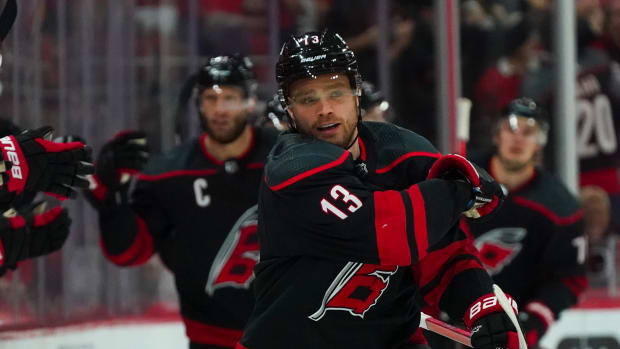
Below, you’ll find the newest file in THN.com’s month-long series of columns on the off-season plans for all 32 NHL teams.On this day, we’re analyzing the Carolina Hurricanes.
2021-22 Record: 54-20-8
Finish In The Metropolitan Division: 1st
Salary Cap Space Available (As Per CapFriendly.com): $19.3 million
Restricted Free Agents: Steven Lorentz, F; Martin Necas, F; Ethan Bear, D; Tony Deangelo, D
Unrestricted Free Agents: Max Domi, F; Nino Niederreiter, F; Derek Stepan, F; Vincent Trochek, F; Ian Cole, D; Brendan Smith, D
What Carolina Has: One of the fastest, slickest lineups in the league; the NHL’s best road team last season (25-12-4); arguably the most emotionally-invested team owner in the league in Tom Dundon; a head coach with few peers in Rod Brind’Amour; a skilled, relatively low-salaried defense corps; and dynamic young forwards in Sebastian Aho, Andrei Svechnikov and Seth Jarvis
What Carolina Needs: Good health from starting goalie Frederik Andersen and defenseman Jake Gardiner; continued contributions from veteran forwards Jordan Staal and Teuvo Teravainen, and more cheap labor from their solid prospects group
What’s Realistic For Carolina Next Season: For most of last season, the Hurricanes dominated opponents with their swiftness and skill, but after outlasting the Boston Bruins in the first round of the Stanley Cup playoffs, the ‘Canes did not have the killer instinct to put away the New York Rangers in Round Two, greatly disappointing fans and emotional owner Tom Dundon. You can blame their early playoff exit on injured starting goalie Frederik Andersen, but backup Antti Raanta (2.25 goals-against average and .922 save percentage in 13 playoff games) gave them a chance to win.
No, the bigger problems for Carolina in the post-season were sub-par special teams (including a power play that was only effective 13.0 percent of the time, and a penalty kill that sagged at 74.0 percent), and, most importantly, an offense that dropped off precipitously from the regular season (in which they averaged 3.38 goals-for per game) to the playoffs (2.64 goals-for per game). That’s not going to cut it, especially when they run into a team like the Rangers that had a bona fide superstar in net. The Hurricanes needed to find a way to grind out goals against a player like Igor Shesterkin, and they couldn’t do so when it counted this spring.
‘Canes GM Don Waddell does have a fair amount of salary cap space to play with, but, with only 14 players signed thus far for the 2022-23 campaign, it’s unlikely Carolina will be shaking the league’s talent tree for a young, restricted free agent the way they did to the Montreal Canadiens last summer when they successfully offer-sheeted forward Jesperi Kotkaniemi. Finding a way to bring back restricted free agent forward Martin Necas and unrestricted free agent forwards Nino Niederreiter and Vincent Trocheck will be difficult enough.
Waddell will have to be creative on the trade and free agent fronts, and it may well come to pass that the Hurricanes will begin the season with less overall depth than they ended this past season with. But that’s not out of the ordinary. That’s how the salary cap is designed to work.
The Metropolitan Division will be just as competitive, if not more so, than it was in 2021-22, but the ‘Canes still have more than enough talent to not only make the playoffs, but to repeat their first-place finish in that group of teams. Ultimately, they are going to be judged by Dundon, fans and media in terms of their playoff run next spring, but as far as the regular season goes, they’ll be about as entertaining as they were last year.
This news is republished from another source. You can check the original article here


